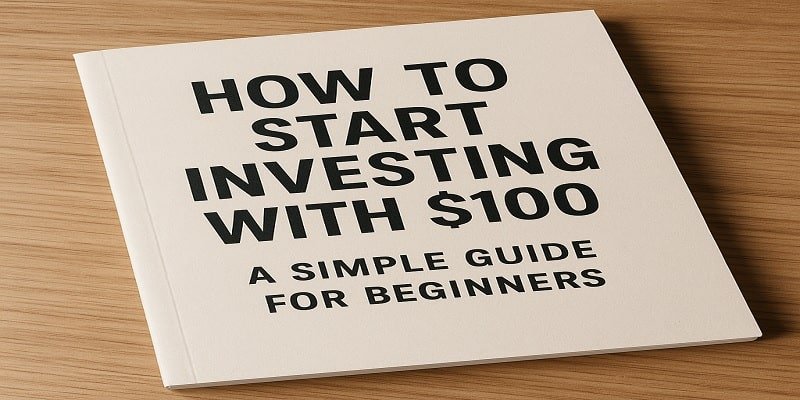(How to Start Investing with $100)
How to Start Investing with $100: Investing can seem daunting, especially if you’re just starting out and only have $100. But guess what? You don’t need thousands of dollars to build wealth. With the right strategy, even a small amount like $100 can grow over time. In this guide, we’ll explain how to start investing with $100 in a way that’s easy to understand and simple for beginners.
Why invest with $100?
You may be wondering, “What can $100 actually do?” The truth is, every great investor started small. The key to success is consistency. By starting early, you reap the benefits of compound interest, where your money earns more over time. Even small, regular investments can pay off in the long run.
Here’s a quick example:
If you invest $100 today and add just $20 each month, with an average 7% annual return, in 30 years you could have over $24,000. That’s the power of investing!
Now, let’s look at the best ways to put your $100 to work.
Step 1: Set clear financial goals
Before you invest, ask yourself:
- What am I investing in? (Retirement, home, emergency fund, etc.)
- How much risk can I take? (Stocks are riskier than bonds, but offer higher returns.)
- When will I need this money? (Short-term vs. long-term goals.)
If you’re investing for long-term growth (such as retirement), you can afford to take more risk. If you need the money soon (within 1-3 years), safer options like high-yield savings accounts may be better.
Step 2: Choose the right investment platform
Many platforms let you start investing with little money. Here are some of the best options:
1. Robo-advisors (best for investing without intervention)
- Examples: Betterment, Wealthfront, Acorns
- Why? These automatically invest your money in diversified portfolios based on your risk level.
- Minimums: Some have a minimum of $0, but $100 is enough to get started.
2. Fractional shares (buy shares with little money)
- Examples: Robinhood, Fidelity, Charles Schwab
- Why? You can buy expensive stocks (like Amazon or Tesla) for just $1.
- Minimums: Typically $0-$5 per fractional share.
3. ETFs and index funds (diversified and low-cost)
- Examples: Vanguard S&P 500 ETF (VOO), SPDR S&P 500 ETF (SPY)
- Why? These spread your money across hundreds of companies, reducing risk.
- Minimum: Some brokers let you buy fractional shares for $1+.
4. High-yield savings accounts (safe but low growth)
- Examples: Ally Bank, Marcus by Goldman Sachs
- Why? If you need cash right away, these pay better interest than regular banks.
- Minimum: Often $0.
Step 3: Choose your investments wisely
With $100, you want to maximize growth without taking unnecessary risks. These are smart ways to invest:
Option 1: Invest in ETFs or index funds (best for beginners)
- Why? These are diversified, low-cost, and track the entire market.
- Example: A $100 investment in an S&P 500 ETF means you own small pieces of the 500 top companies.
Option 2: Buy fractional shares of stocks
- Why? If you believe in companies like Apple or Google, you can buy a portion of them without paying full price.
- Tip: Invest in established companies instead of risky penny stocks.
Option 3: Try a robo-advisor
- Why? It handles everything for you—great if you don’t want to pick stocks yourself.
Option 4: Invest in a retirement account (IRA)
- Why? If you’re saving for retirement, an IRA offers tax benefits.
- Example: A Roth IRA lets your money grow tax-free.
Step 4: Avoid common mistakes
New investors often make these mistakes—avoid them!
Mistake 1: Trying to get rich quickly
Solution: Investing is a long-term game. Avoid betting on meme stocks or trends.
Mistake 2: Paying high fees
Solution: Stick to low-cost ETFs (expense ratio less than 0.20%).
Mistake 3: Not diversifying
Solution: Don’t put all $100 in one stock. Split it across ETFs or multiple assets.
Step 5: Keep investing regularly
The real magic happens when you keep adding money. Here’s how:
- Set up automatic transfers (adds up $20/month!).
- Reinvest dividends (if your platform allows it).
- Increase contributions as your earnings grow.
Final Thoughts: Start Now, Grow Over Time
You don’t need to be rich to start investing—$100 is enough to get started. The key is to start early, invest consistently, and keep learning. Whether you choose an ETF, fractional share, or robo-advisor, the important thing is to take the first step.
Remember, even Warren Buffett started with just $100. Your future self will thank you!
Ready to get started?
- Open a brokerage account (like Robinhood or Fidelity).
- Choose an ETF or fractional stock.
- Invest your $100 and watch it grow!
Happy investing!
By following these steps, you’ll be on your way to growing your money, even if you only have $100 to start. Please keep it simple, be patient, and let time work in your favor!
FAQs about how to start investing with $100
1. Is $100 enough to start investing?
Yes! Many platforms let you buy fractional shares (fractional stocks) or low-cost ETFs for less than $1. Apps like Robinhood, Fidelity, and Acorns make it easy to start small. The key is consistency—regular contributions can add up over time.
2. What’s the safest way to invest $100?
For safety, consider:
- High-yield savings accounts (low risk, but low returns).
- Index funds or ETFs (diversified, lower risk than single stocks).
- Robo-advisors (automated, balanced portfolios).
If you’re prioritizing safety, avoid risky bets like penny stocks or crypto.
3. Can I make money quickly with $100?
Probably not—and that’s okay. Investing is a long-term strategy, not a get-rich-quick scheme. While stocks can rise quickly, they can also fall. Focus on steady growth through compound interest rather than betting on volatile assets.
4. Do I need a broker to invest $100?
Yes, but many brokers have no minimums or fees. Popular options include:
- Robinhood (easy for beginners, fractional shares).
- Fidelity (great for ETFs and retirement accounts).
- Acorns (store spare change to invest).
5. How often should I invest after the first $100?
As often as possible! Even $10-$20 a month adds up over time. Set up automatic transfers to get into the habit. The earlier you invest, the more compound interest works in your favor.


